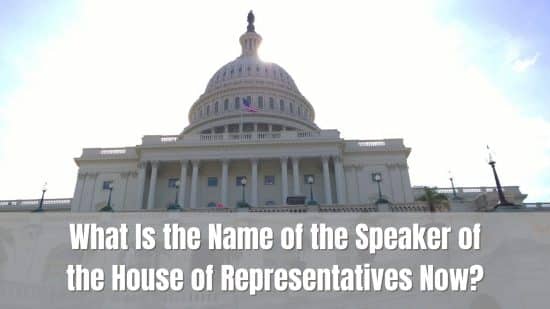To pass the US citizenship test, you will have to answer 10 of a possible 100 questions. The following question is from the USCIS test.
What is the name of the Speaker of the House of Representatives now?
Answer:
Nancy Pelosi.
The following is a full explanation of the USCIS question:
California Democrat Nancy Pelosi is the current Speaker of the House of Representatives. She was named Speaker in 2019 and was also the Speaker from 2007 to 2010.
Pelosi became the first woman to hold the Speaker of the House position when she became Speaker of the 110th United States Congress on January 4, 2007. She was elected as Speaker of the 111th Congress in 2009 but forfeited the position after the Democratic Party lost control of the House in 2011.
Pelosi returned to the Speaker role for the 116th United States Congress on January 3, 2019, as the Democrats took back the House. She will continue to be the Speaker until at least January 3, 2023, when the 117th Congress will end.
What Does the Speaker Do?
The Speaker of the House of Representatives is responsible for leading the House during the Congressional term. They hold many duties in the office:
- The Speaker helps prepare the general agenda for the House during the term. The work includes explaining legislative actions managed during a session to other officials and the public.
- The Speaker will review House committee assignments and prepare the rules of floor debate with the House Rules Committee.
- The Speaker will oversee all offices in the House, including the offices of the clerk, sergeant-at-arms, chief administrative officer, and chaplain.
- Various communications and reports from the President or other government agencies can go through the Speaker before they are brought out to the House floor.
- All rules for debate and other actions within the House will be monitored and executed by the Speaker.
- The Speaker could also prepare a drug-testing system within the House, although the House has never followed through on this option.
Who Picks the Speaker?
Other members of the House will pick who the Speaker will be at the start of the new Congressional session. The Representatives serving in the new session will vote in their party caucuses to determine the speaker. Whoever has a majority of votes to become the Speaker will receive the title.
The party in control of the House will typically ensure the Speaker will be of the same party. For example, Nancy Pelosi’s first two terms as the Speaker came when the Democrats had control over the House. Republican John Boehner took over the Speaker title after the House Republicans took control. Paul Ryan eventually replaced him before Pelosi could get the Speaker title back when the Democrats regained control of the House.
The Speaker must be someone who is elected to serve in the House. Pelosi was initially elected to serve in the eighth district of California, which included parts of San Francisco and San Mateo at the time. Pelosi’s return to the office came as she was in the twelfth district of California, which entirely covers the city of San Francisco.
How does the election process work?
The House’s efforts to pick the Speaker will entail someone being nominated to be the next Speaker. The political party members will vote in a caucus to determine who will be the candidate for that party. The Democrats and Republicans will have separate caucuses for their candidates.
The House members will then go through a roll call vote after the start of the Congressional session. Whoever receives the most votes in a simple majority during the roll call will be named the Speaker.
Is the election process really divided by party?
In most situations, the Speaker will be from the party controlling the House, with that party having more power over the roll call vote. But House members can cross the aisle and vote for someone from a different party. Others may choose to vote for another person in their party mainly because they aren’t confident in who was chosen in the caucus.
For example, the 2019 Speaker of the House election saw Nancy Pelosi receive votes from all but fifteen of the Democrats in the House. There were multiple Democrats who had a few votes, with Illinois’ Cheri Bustos getting four. All but six Republicans voted for California’s Kevin McCarthy, with Ohio’s Jim Jordan receiving four votes after finishing as the runner-up to McCarthy in the Republican caucus.
How Long Can Someone Be a Speaker?
A person elected the Speaker of the House will hold that position for the entire two-year Congressional period. But there are no particular rules for how long someone could hold the Speaker position over the course of their political career. As long as that person continues to be elected to the position, that someone can remain the Speaker.
Texas Democrat Sam Rayburn is the longest-serving Speaker in the nation’s history. He was elected to the Speaker position ten times, first in September 1940 following the death of predecessor and Alabama Democrat William Bankhead. Rayburn served from then to 1946, from 1949 to 1952, and from 1955 to his death in November 1961.
Massachusetts Democrat Tip O’Neill has the longest uninterrupted tenure as the Speaker, as he served from 1977 to 1986. New York Republican Theodore Pomeroy had the shortest run as Speaker, as he was the Speaker for one day in 1869. He was temporarily in charge of the position after Schulyer Colfax resigned from office, prompting a special election to determine the next Speaker.
Where Does the Speaker Appear in the Line of Presidential Succession?
The Speaker is second in the line of Presidential succession and is only behind the Vice President. If the President and Vice President were both unable to serve their duties, the Speaker would receive the powers and duties of the presidency. This rule is in the Constitution under Article II, Section 1.
Could the Speaker Be Independent?
All 54 people who have served as the Speaker of the House of Representatives have been affiliated with a political party. Most of these people have been associated with the Democratic or Republican Party, but many since-defunct parties have also had control over this position. There were two Federalist Speakers around the end of the eighteenth century, while Nathaniel Banks remains the only Speaker in history to have come from the American Party.

Get Smarter on US News, History, and the Constitution
Join the thousands of fellow patriots who rely on our 5-minute newsletter to stay informed on the key events and trends that shaped our nation's past and continue to shape its present.




